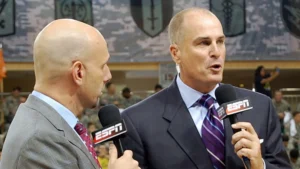By David Mullen
On the surface, the 2025 NCAA Final Four looks like a series for the ages. The four No. 1 seeds — Auburn, Duke, Houston and Florida — from the four regions will gather in San Antonio’s Alamodome to compete for the NCAA Men’s Basketball Championship on Saturday, April 5 and Monday, April 7.
The NCAA Division I Men’s Basketball Committee got it right this year. There are no Cinderellas at this year’s Big Dance. And it is unlikely that a Cinderella team will emerge in the future.

Unexpected runs from unheralded teams like the No. 11 seeded 2006 George Mason Patriots, who defeated No. 3 North Carolina and the No. 1 Connecticut Huskies on the way to the 2006 Final Four and the 2018 No. 11 2018 Loyola Chicago Ramblers, inspired by 98-year-old mega fan Sister Jean Dolores Schmidt, are, like Cinderella, stories from the past.
Victories by the No. 8 seed Butler Bulldogs over the Shaka Smart-coached No. 11 VCU Rams in a Final Four match in 2011 or the No. 8 seed 1985 Villanova Wildcats, under the direction of Rollie Massimino, beating the heavily favored and defending champion Georgetown Hoyas with center Patrick Ewing, may never happen again.
Get used to it, because that is what has become of March Madness. It is March Moolah. Only teams from elite conferences advance in March Madness.
This year’s representatives are among the four best teams that money can buy. NCAA basketball is no longer about team spirit, loyalty and pride of university. It is all about the Benjamins. Degrees have long ago been replaced by dollars.
The association between NCAA Men’s College Basketball and amateur athletics is a ship that sailed long ago. It is all about how much money a university can spend to compensate a “student athlete,” before the player enters a transfer portal as a commodity item and joins the college providing the best financial opportunity. The lack of policing the NIL (Name, Image Likeness) by the NCAA and the universities themselves has turned college basketball into the latest professional sport.
As a glaring weakness of college basketball losing purpose thanks to the transfer portal, teams can begin signing players off other college teams’ rosters as early as March 24, when 16 teams are still competing for a National Championship. Restrictions have been lifted or caught the NCAA off guard before they could react. More than 1,600 players have already entered the transfer portal, and the season hasn’t even ended yet.
Of the 68 teams that qualified for the NCAA tournament, 14 of the 16 Southeastern Conference (SEC) teams received bids. No First Four play-in teams made it past the first round, including No. 11 seed Texas, for only the second time since the NCAA expanded the championship from 64 to 68 teams in 2011.
Freshman sensation and Final Four participant 18-year-old Duke forward Cooper Flagg put on a show at the Team USA basketball camp in Las Vegas last summer, scrimmaging against NBA great LeBron James, Stephen Curry, Kevin Durant and the Dallas Mavericks Anthony Davis before they headed for the 2024 Paris Olympics.
The innocent looking kid from Newport, Maine, proved that he can play, and the NIL money followed him to Duke. Flagg signed sponsorship and marketing deals with New Balance, Fanatics and Gatorade. He is estimated to earn nearly $6 million as a Duke freshman. He won’t enter the player portal after Duke’s Final Four challenge has ended. He is headed for the NBA Draft.
Why should the NBA fund a minor league system when the NCAA does it for them?
“Every season and every NCAA tournament is different,” wrote former Duke player, Mavericks’ draft pick and current ESPN college basketball analyst Jay Bilas (pictured above), “which is one of the beautiful things about the event. Two years ago, San Diego State and Florida Atlantic reached the Final Four, and the overarching narrative was that NIL and the transfer portal had flattened the Earth, that talent would be more spread out and the reign of the major conferences could be over.
“This year,” Bilas continued, “upsets were not as prevalent, and all 16 teams in the Sweet 16 were from four major conferences (seven from the SEC, four from the Big Ten, four from the Big 12 and one from the ACC). Now, it was said, the transfer portal and NIL have killed mid-majors, who are just organ donors for the major conferences.” Bilas correctly predicted the 2025 Final Four teams on his bracket, published on espn.com.
Before 2025, upsets were part of March Madness. Now, it appears that only a Power Four conference (SEC, Big Ten, Big 12, and ACC) team, like this year’s Final Four participants, will compete in upcoming NCAA Men’s Basketball tournaments. Teams without the resources have to outplay and depend on luck to vie with the elite teams. They can’t outspend them. Chances are teams like San Diego State or Florida Atlantic, the Florida Gulf Coast Eagles or the Saint Peter’s Peacocks competing for a National Championship are part of a bygone era.
In 2025, Cinderella, like in years to come, won’t make it to the dance.
